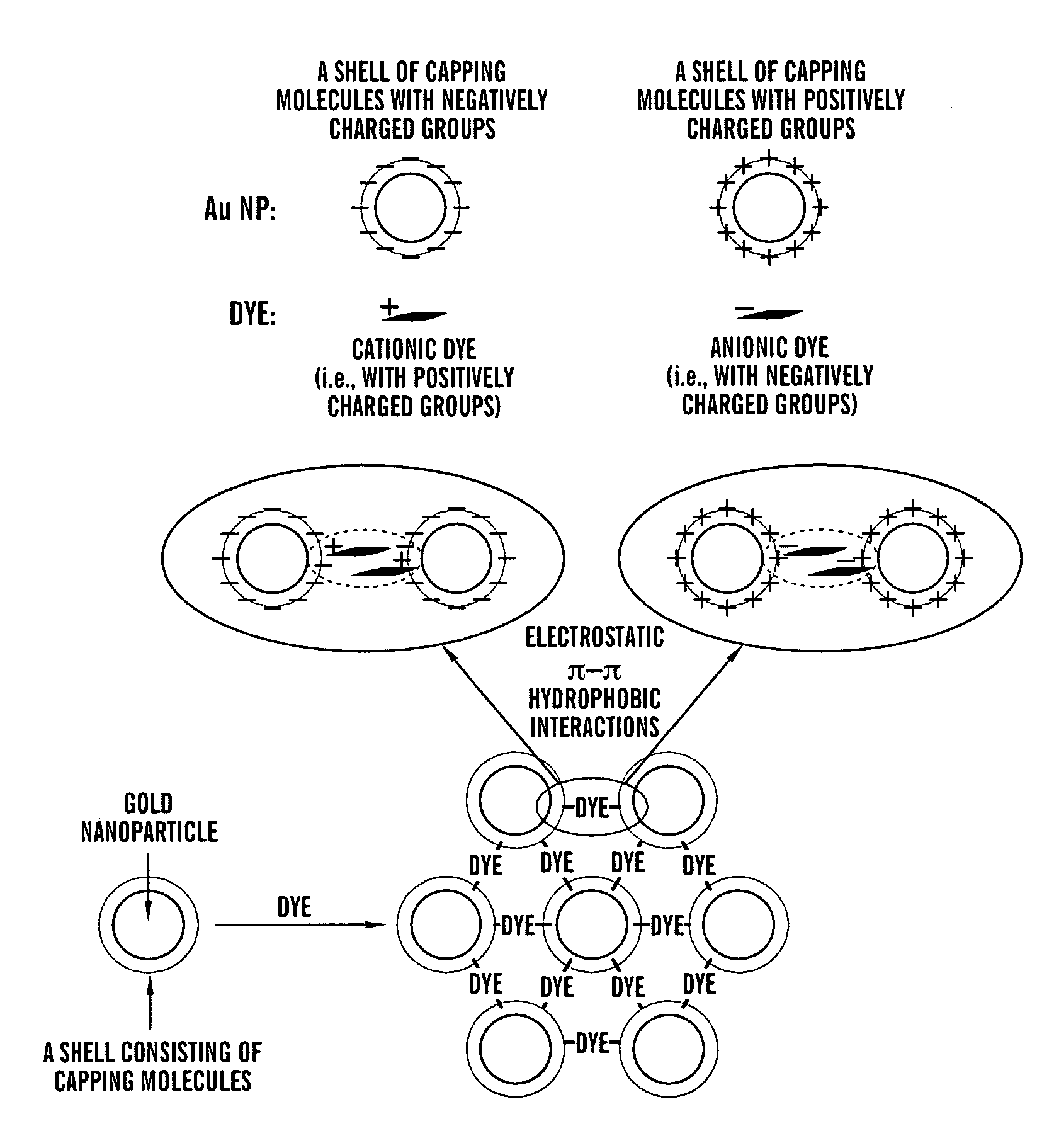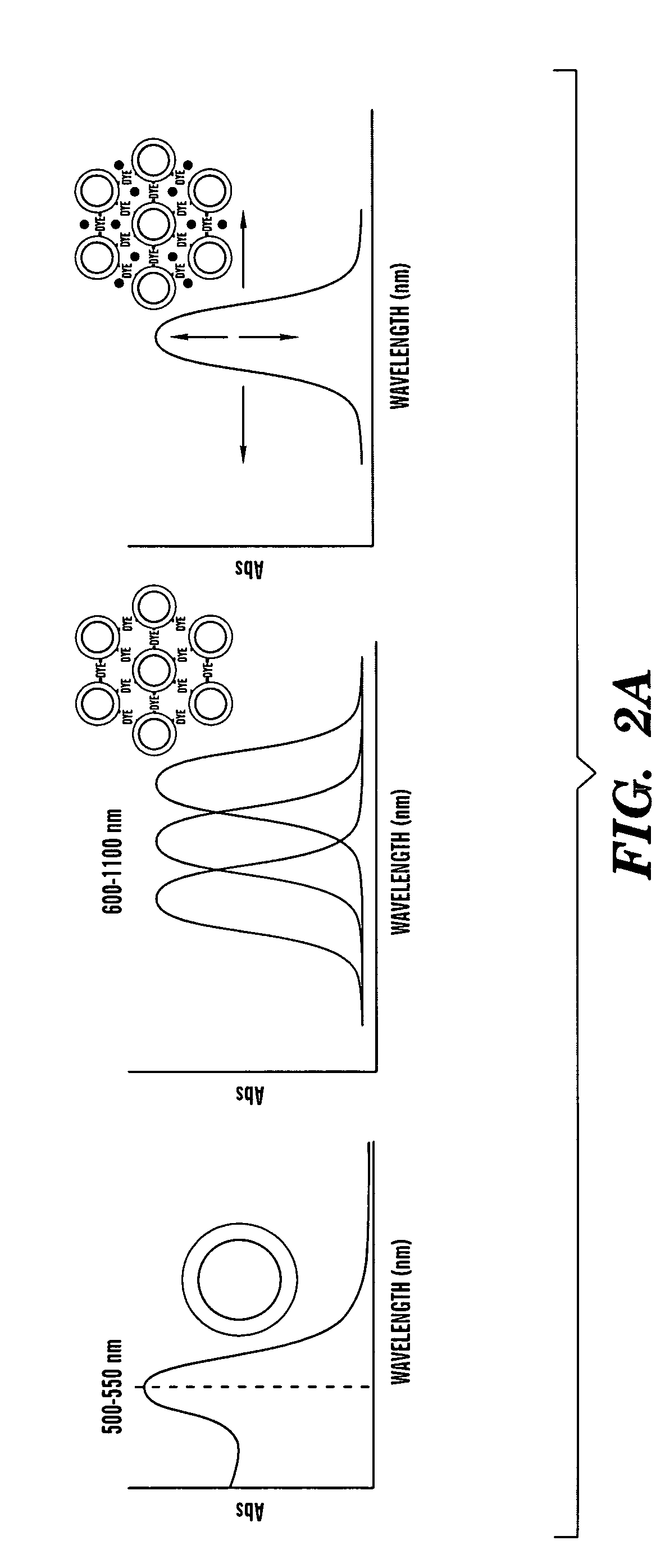Aggregates of plural transition metal nanoparticles and plural cyanine dye molecules
a technology of transition metal nanoparticles and cyanine dye molecules, which is applied in the field of aggregates of plural transition metal nanoparticles and plural cyanine dye molecules, can solve the problems of relatively little attention to how interparticle interactions and reactivities can be utilized for nanostructured assembly, and achieve the highest reactivity, disassembly of the network structure of icd-aunm, and further study of the tunability of nanoparticle network structur
- Summary
- Abstract
- Description
- Claims
- Application Information
AI Technical Summary
Benefits of technology
Problems solved by technology
Method used
Image
Examples
example 1
Chemicals
[0056]The chemicals included hydrogen tetracholoroaurate (HAuCl4, 99%), sodium citrate (Cit, 99%), and ethanol (EtOH, 99.9%). All chemicals were purchased from Aldrich and used as received. Water was purified with a Millipore Milli-Q water system.
[0057]The cyanine dyes were obtained from Crysta-lyn Chemical Inc. Details for the synthesis of the dyes have been reported. See Li, Q., et al., Molecules 2; 91 (1997); Hamer, F. M., The Cyanine Dyes and Related Compounds, Wiley & Sons: New York, Vol. 18 (1964), which are hereby incorporated by reference in their entirety.
[0058]The synthesis of citrate-capped gold nanoparticles (Aunm) followed the reported procedure (see Grabar, K. C., et al., Anal. Chem. 67: 735 (1995), which is hereby incorporated by reference in its entirety). Briefly, aqueous AuCl4− (1 mM) was heated to boiling under vigorous stirring in a cleaned glass flask. At reflux, an excess (×3.8) of sodium citrate (38.8 mM stock solution) was quickly added into the solu...
example 2
Measurements and Instrumentation
[0059]The dye mediated assembly of Aunm was carried out under ambient conditions. Briefly, upon adding a desired amount of dye solution (in ethanol) into aqueous solution of nanoparticles or vice versa, the solution was quickly mixed by purging for ˜2 sec before the measurement of UV-Visible (UV-Vis) spectra. The spectra were collected over the range of 200-1100 nm with a HP 8453 spectrophotometer. A quartz cuvette with a path length of 1.0 cm was utilized. The stock concentration of gold nanoparticles was determined according to the absorbance data and the average size of the particles. As previously reported, the molar absorptivity (∈Au) for a 13-nm sized Aunm particles determined in aqueous solution at the surface plasmon resonance band maximum (λ=520 nm) was 2.01×108 M−1·cm−1. For ICD, the value of ∈dye (ICD) determined at λ=550 nm in aqueous solution was 1.15×105 M−1 cm−1. See Maye, M. M., et al., Anal. Chemie. Acta. 496: 17 (2003), which is here...
example 3
SERS Spectra for ICD-Aunm Assembly
[0062]The understanding of the surface interaction and stability of the ICD-Aunm assembly is studied using SERS. FIG. 5 represents a set of data obtained for the ICD-Aunm assembly as a function of time. As reported, the detection of dye molecules itself using SERS without any attachment to silver or gold nanoparticles is unfeasible. However, strong and distinct peaks are observed from the SERS spectrum when the dye molecules are attached to silver or gold nanoparticles. This allows it to act as a reporter molecule in a SERS optical probe. See Kneipp, J., et al., Anal. Chem. 77: 2381 (2005), which is hereby incorporated by reference in its entirety. Hence, upon the addition of Aunm, the assembly solution was studied as a function of time (˜80 min). An important finding in this experiment is that the intensity of the ICD mediated assembly of Aunm gradually decreases as time increase. This is due to the π-π interaction of the dye assembly. The intensit...
PUM
| Property | Measurement | Unit |
|---|---|---|
| diameter | aaaaa | aaaaa |
| time | aaaaa | aaaaa |
| diameters | aaaaa | aaaaa |
Abstract
Description
Claims
Application Information
 Login to View More
Login to View More - R&D
- Intellectual Property
- Life Sciences
- Materials
- Tech Scout
- Unparalleled Data Quality
- Higher Quality Content
- 60% Fewer Hallucinations
Browse by: Latest US Patents, China's latest patents, Technical Efficacy Thesaurus, Application Domain, Technology Topic, Popular Technical Reports.
© 2025 PatSnap. All rights reserved.Legal|Privacy policy|Modern Slavery Act Transparency Statement|Sitemap|About US| Contact US: help@patsnap.com



